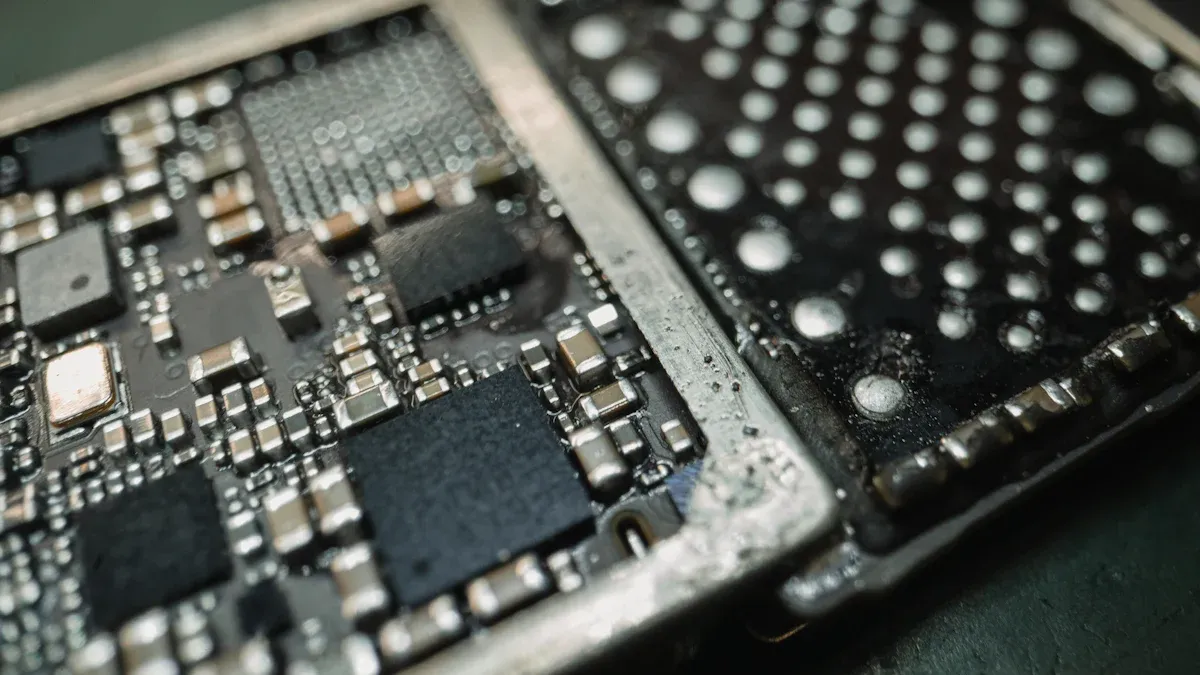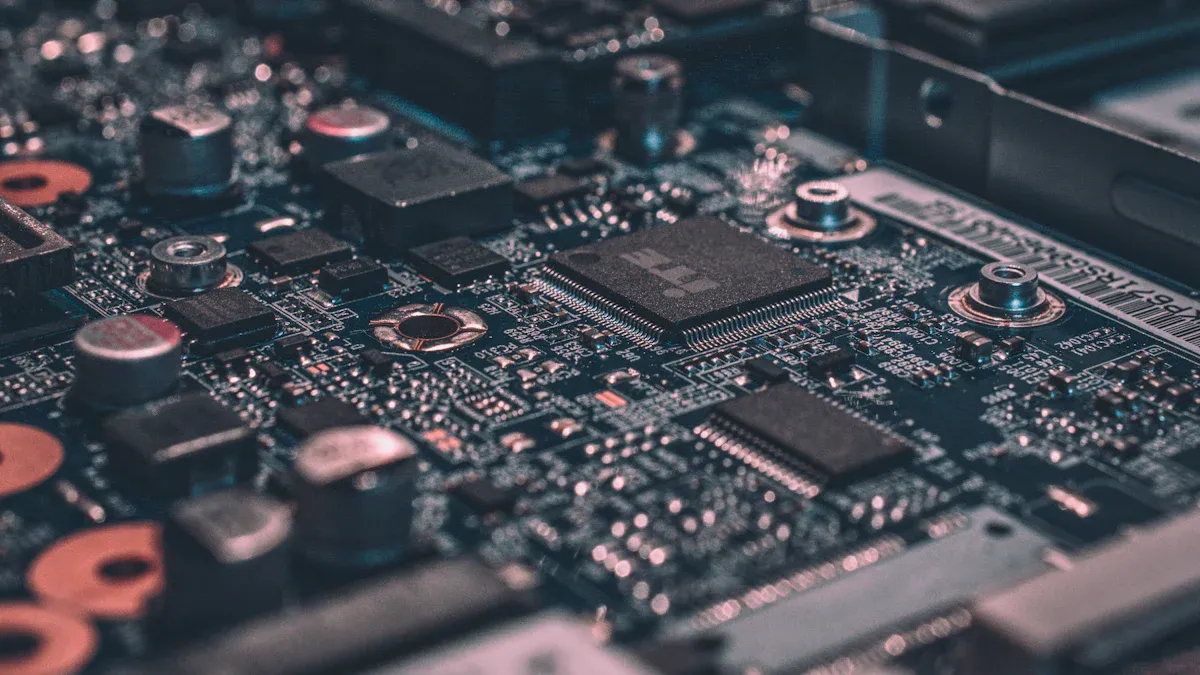
The PT2313 IC voltage typically ranges from 4.5V to 10V, with 5V often considered ideal for most applications. Engineers choose this range to ensure stable operation and protect the chip from damage. Exceeding or dropping below the recommended voltage can lead to unreliable performance, poor audio quality, or even permanent failure.
Key Takeaways
-
Keep the PT2313 IC voltage between 4.5V and 10V for safe and reliable operation.
-
Use 5V as the ideal voltage to get the best audio quality and stable performance.
-
Always use a regulated power supply and add capacitors near the IC to keep voltage steady and reduce noise.
-
Avoid voltage spikes and drops by checking the voltage at the IC pins during normal use.
-
Following these voltage guidelines protects the chip from damage and ensures clear, high-quality sound.
PT2313 IC Voltage Range

Recommended Voltage
Engineers often select 5V as the recommended PT2313 IC voltage for most audio applications. This value ensures the chip operates with optimal efficiency and stability. The PT2313 datasheet highlights 5V as a standard supply voltage, which matches the requirements of many digital and analog circuits. When the PT2313 IC voltage stays at 5V, the device delivers consistent audio performance and maintains low distortion. Most consumer audio systems use this voltage because it balances power consumption and output quality.
Acceptable Range
The PT2313 IC voltage can safely operate within a typical range of 4.5V to 10V. This range allows flexibility for different system designs and power sources. The PT2313 datasheet provides detailed electrical characteristics, including sections like "Quiescent Current vs. Supply Voltage," which show how the chip behaves across this range. Designers should keep the voltage between 4.75V and 5.25V for systems that require precise 5V operation. This tighter window helps maintain reliable performance, especially in environments with fluctuating temperatures. The IC continues to function well as long as the voltage remains within the broader 4.5V to 10V span.
Note: Always check the PT2313 datasheet for the most accurate and up-to-date voltage recommendations, especially when designing for extreme temperature conditions.
Maximum Limit
The PT2313 IC voltage must never exceed 10.2V. This value represents the absolute maximum rating specified by the manufacturer. Exceeding this limit can cause permanent damage to the internal circuitry. The datasheet warns that operation above this voltage, even for short periods, may lead to device failure. System designers should include safeguards, such as voltage regulators or protection circuits, to prevent accidental overvoltage. Maintaining the PT2313 IC voltage below the maximum limit ensures long-term reliability and safety.
Importance of Correct Voltage
Performance Impact
Correct voltage plays a key role in the performance of the PT2313 IC. When engineers supply the recommended voltage, the chip delivers clear audio output and stable operation. The internal circuits work as designed, so users experience minimal distortion and noise. Consistent voltage also helps the IC maintain accurate volume control and tone adjustment. Many audio systems rely on this stability to produce high-quality sound.
A steady PT2313 IC voltage ensures that the device responds quickly to user commands. The chip processes signals efficiently, which leads to smooth transitions between audio sources or settings. In professional audio equipment, this reliability becomes even more important. Musicians and sound engineers depend on precise control, and the correct voltage makes this possible.
Tip: Use a regulated power supply to keep voltage fluctuations to a minimum. This practice helps maintain the best possible audio performance.
Risks of Incorrect Voltage
Supplying the wrong voltage can cause several problems. If the voltage drops too low, the PT2313 IC may not function at all. Users might notice weak audio output, unexpected shutdowns, or loss of control features. On the other hand, if the voltage rises above the maximum limit, the chip can overheat or suffer permanent damage.
Some common risks include:
-
Distorted or noisy audio signals
-
Unresponsive volume or tone controls
-
Shortened device lifespan
-
Complete failure of the IC
Manufacturers design the PT2313 IC to work within a specific voltage range. Ignoring these limits puts the entire audio system at risk. Careful attention to voltage protects both the chip and the equipment.
Power Supply Tips

Stable Supply
A stable power supply helps the PT2313 IC perform at its best. Engineers often choose regulated power adapters or linear voltage regulators for this purpose. These devices keep the voltage steady, even when the input power changes. Clean and stable voltage reduces noise in audio circuits. It also prevents sudden drops or spikes that can harm the IC.
To achieve a stable supply, designers often use these methods:
-
Use a quality voltage regulator: This device keeps the output voltage constant.
-
Add filter capacitors: Placing capacitors near the IC helps smooth out small voltage changes.
-
Check for voltage drops: Long wires or thin traces can cause voltage loss. Keep connections short and thick.
-
Monitor temperature: High temperatures can affect voltage stability. Place the IC in a cool area if possible.
Tip: Always measure the voltage at the IC pins, not just at the power supply output. This practice ensures the chip receives the correct voltage.
Common Mistakes
Many designers make simple errors when powering the PT2313 IC. These mistakes can lead to poor performance or even damage.
Some common mistakes include:
-
Using an unregulated power source: Unregulated adapters can cause voltage swings. These swings may push the voltage outside the safe range.
-
Ignoring voltage ripple: Ripple is a small, rapid change in voltage. Too much ripple can create noise in the audio signal.
-
Skipping decoupling capacitors: Without these capacitors, the IC may pick up interference from other parts of the circuit.
-
Overlooking startup surges: Some power supplies create a brief voltage spike when turned on. This spike can exceed the maximum limit for the IC.
-
Not checking the PT2313 IC voltage under load: The voltage may drop when the circuit draws more current. Always test the voltage during normal operation.
Note: Careful planning and regular testing help prevent these mistakes. Reliable power keeps the audio system running smoothly.
Quick Reference
Voltage Table
For engineers and hobbyists, a quick reference table helps confirm the correct voltage settings for the PT2313 IC. This table lists the most important voltage values, including the recommended, acceptable, and maximum limits. Users can check this table during design, testing, or troubleshooting.
| Voltage Parameter | Value | Description |
|---|---|---|
| Recommended Voltage | 5V | Standard supply for optimal performance |
| Acceptable Range | 4.5V – 10V | Safe operating range for most applications |
| Tight 5V Range | 4.75V – 5.25V | Preferred for precise 5V systems |
| Absolute Maximum Voltage | 10.2V | Do not exceed this value to avoid damage |
Note: Always measure the voltage at the IC pins. This practice ensures the PT2313 IC receives the correct supply, even if there are losses in the wiring.
A quick checklist for voltage setup:
-
Use a regulated power supply to maintain stable voltage.
-
Add decoupling capacitors near the IC.
-
Monitor voltage during normal operation, not just at startup.
Engineers should keep this table handy when working with the PT2313 IC. The table provides a fast way to verify that the voltage stays within safe limits. Following these guidelines helps prevent common mistakes and protects the IC from damage.
A reliable voltage supply supports clear audio output and long device life. Careful attention to these values ensures the PT2313 IC voltage remains within the recommended range.
Engineers should always keep the PT2313 IC voltage within the recommended range of 4.5V to 10V. Stable voltage ensures reliable performance and protects the device from damage.
-
Double-check the power supply before connecting the IC.
-
Review the datasheet for the latest technical details.
Careful attention to voltage helps every audio project succeed.
FAQ
What happens if the PT2313 IC receives less than 4.5V?
The IC may not function correctly. Users might notice weak audio, loss of control, or the device may not turn on. Always keep the voltage above 4.5V for reliable operation.
Can the PT2313 IC run directly from a USB 5V supply?
Yes, the PT2313 IC works well with a standard USB 5V supply. Use a quality USB power source and add decoupling capacitors for best performance.
How can engineers protect the PT2313 IC from voltage spikes?
Use a voltage regulator and place decoupling capacitors near the IC. These components help absorb spikes and keep the voltage stable.
Is it safe to operate the PT2313 IC at 10V for long periods?
Engineers can operate the IC at 10V, but this value sits near the upper limit. For long-term reliability, most designers prefer 5V to 9V.
What should users check if the audio output sounds distorted?
-
Verify the supply voltage at the IC pins.
-
Inspect for voltage ripple or unstable power.
-
Ensure all decoupling capacitors are in place.
Stable voltage often solves most audio distortion issues.
Written by Jack from AIChipLink.
AIChipLink, one of the fastest-growing global independent electronic components distributors in the world, offers millions of products from thousands of manufacturers, and many of our in-stock parts is available to ship same day.
We mainly source and distribute integrated circuit (IC) products of brands such as Broadcom, Microchip, Texas Instruments, Infineon, NXP, Analog Devices, Qualcomm, Intel, etc., which are widely used in communication & network, telecom, industrial control, new energy and automotive electronics.
Empowered by AI, Linked to the Future. Get started on AIChipLink.com and submit your RFQ online today!












